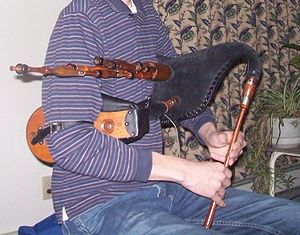- Scottish smallpipes
-
The Scottish smallpipe, in its modern form, is a bellows-blown bagpipe developed by Colin Ross and others, to be playable according to the Great Highland Bagpipe fingering system.[1] There are surviving examples of similar historical instruments such as the mouth-blown Montgomery smallpipes in E, dated 1757, which are now in the National Museum of Scotland. There is some discussion of the historical Scottish smallpipes in Collinson's history of the bagpipes.[2] Some instruments are being built as direct copies of historical examples,[3] but few modern instruments, though, are directly modelled from older examples; the modern instrument is typically larger and lower pitched. The innovations leading to the modern instrument, in particular the design of the reeds, were largely taken from the Northumbrian smallpipes.
Contents
Characteristics
Scottish Smallpipes are distinguished from the Northumbrian smallpipes by having an open end to the chanter, and usually by the lack of keys. This means that the sound of the chanter is continuous, rather than staccato, and that its range is only nine notes, rather than the nearly two octaves of the Northumbrian pipes. A further distinction from the Northumbrian smallpipes is that the Scottish Smallpipes lack an unbroken line of traditional playing.
The instrument has a cylindrically bored chanter, most commonly pitched in A, although any key is feasible; D, C, and B flat are also common keys. Being cylindrically bored, the chanter sounds an octave lower than a conical-bored chanter of the same size, such as that of the Border pipes. The fingering system is identical to that of the Great Highland pipes.
Scottish Smallpipes are normally bellows-blown like the Northumbrian pipes and Border pipes. Mouth-blown versions are also available, but they are less common because the moist air tends to injure the cane reeds.
It is most commonly unkeyed, but occasionally high B, G sharp, F natural, and C natural keys are added. Though it would in principle be possible to add as many keys as to the modern Northumbrian smallpipes, not many pipers use a set with more than a few keys. Most music written for the instrument uses only the nine notes of its unkeyed range.
The drones, typically three in number, are set in a common stock and are usually tuned in one of two patterns. For pipes in A, the tenor drone is tuned to the low "A" of the chanter, usually the tonic note, and the bass drone to the "A" an octave below this. There is also sometimes a dominant drone - this can be either a baritone, tuned a fifth above the bass, or else an alto drone, tuned a fifth above the tenor. For tunes in the key of D, the dominant drone can be either shut off or retuned. Most makers now prefer to make a baritone drone, rather than an alto, and many use only the bass and tenor. Other makers have developed drones compatible with both A and D chanters, so that one instrument can be used with either chanter. These sets include both A and D drones. One example is the "ADAD" style, with bass, baritone, tenor, and alto, as seen here:[1]. And by using longer tuning pins, and northumbrian smallpipes-influenced tuning beads, some smallpipe drones can easily be retuned to a pitch one or two tones higher. A Baritone drone in C can be retuned to D, or E for example.[4][5] This allows for increased drone tuning options, such as playing fifth or fourth tuned baritone or alto drones.
History
It is perhaps the youngest bagpipe with any popularity, having only existed in its modern form since the early 1980s. It is extremely popular, particularly with Highland pipers, many of whom keep it or a set of Border pipes as a second instrument. Though it has somewhat supplanted the musically unsatisfactory Highland practice chanter as a relatively quiet rehearsal instrument for Highland pipers, it has gained wide currency as a session instrument, for both the Highland and Border pipe repertoires.
The Scottish smallpipes were the first widely available instrument to allow Highland pipers to participate in musical sessions with fiddlers, flautists and other instruments, as well as to accompany singers. However, modern Scottish Border pipes, many of which are becoming quieter and more reliable than their predecessors, may slowly be replacing the Scottish Smallpipes as the highland piper's session instrument of choice.
References
- ^ http://www.hamishmoore.com/essay.htm#Hamish Hamish Moore
- ^ http://books.google.co.uk/books?id=Sds9AAAAIAAJ#Collinson Collinson, F., The Bagpipe, The history of a Musical Instrument, Routledge & Kegan Paul, London, 1975, ISBN - 0710079133
- ^ http://www.goodbagpipes.co.uk
- ^ Nate Banton's Quick Start Guide to Scottish Smallpipes
- ^ Ian Ketchin Smallpipes
External links
See also
- Bagpipe
- List of Smallpipe makers
Categories:- Bagpipes
- Scottish musical instruments
Wikimedia Foundation. 2010.

